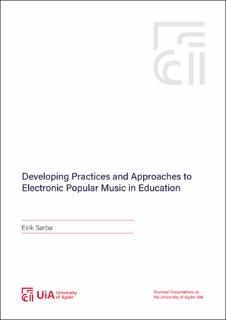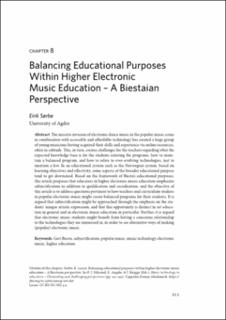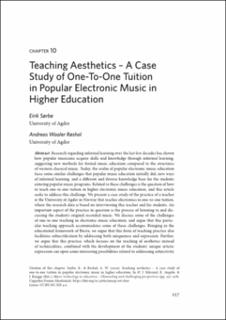| dc.contributor.author | Sørbø, Eirik | |
| dc.date.accessioned | 2023-04-27T12:31:46Z | |
| dc.date.available | 2023-04-27T12:31:46Z | |
| dc.date.created | 2023-04-17T13:40:13Z | |
| dc.date.issued | 2023 | |
| dc.identifier.citation | Sørbø, E. (2023). Developing Practices and Approaches to Electronic Popular Music in Education [Doctoral dissertation]. University of Agder. | en_US |
| dc.identifier.isbn | 978-82-8427-111-8 | |
| dc.identifier.uri | https://hdl.handle.net/11250/3065348 | |
| dc.description | Paper III and paper IV are excluded from the dissertation until they are published. | en_US |
| dc.description.abstract | The field of electronic popular music education is a relative newcomer compared to most other educational fields within the arts, and the relationships between educational purposes, between the teacher and the students, and between technology and musical parameters are not as established as they are elsewhere. Through the four articles constituting this thesis, various ways of teaching electronic popular music are explored, all of which emphasize to some degree these relationships. In Article 1, I make broad discussions using continental educational theory—in particular, the work of Biesta—to generate pertinent questions for educators within electronic popular music education. I also introduce and develop an understanding of artistic subjectification as a means of facilitating subjectification (in the Biestaian sense), one that I argue is unique to art education. Article 2 presents a case study of the one-to-one teaching approach of a teacher in electronic music, and points to how one might teach technologies by simply ignoring them and focusing exclusively on the aesthetic parameters of the music, then leaving it up to the student to figure out how to technically achieve their creative endeavors. These two articles together point to how teachers can help students (re)gain agency in their creative practices through both explicitly focusing on how technologies mediate their practices and through ignoring technology altogether. The third article explores the tension between continental educational thinking and student-centered education via the case study of a task for activating student expertise in electronic popular music education, based on that tension. It then frames the findings of this case study within a proposed teaching method, and finally introduces the concept of middle ground teaching. Article 4 provides a case study of a collaborative music making camp involving 16 students, and develops from this case study the model of aesthetic dialogue that points to various aspects that influence the quality and efficiency of the collaboration. These two articles together point to ways of approaching fragmented knowledges and skills and tackling the diverse backgrounds of students. | en_US |
| dc.language.iso | eng | en_US |
| dc.publisher | University of Agder | en_US |
| dc.relation.ispartof | Doctoral dissertations at University of Agder | |
| dc.relation.ispartofseries | Doctoral dissertations at University of Agder; no. 398 | |
| dc.relation.haspart | Paper I: Sørbø, E. (2020). Balancing Educational Purposes Within Higher Electronic Music Education – A Biestaian Perspective. In Ø. J. Eiksund, E. Angelo & J. Knigge (Eds.) Music Technology in Education – Channeling and Challenging Perspectives (pp. 257-278). Cappelen Damm Akademisk. doi: 10.23865/noasp.108.ch8. Published version. Full-text is available in AURA as a separate file: https://hdl.handle.net/11250/3063682 | en_US |
| dc.relation.haspart | Paper II: Sørbø, E. & Røshol, A. W. (2020). Teaching Aesthetics – A Case Study of One-To-One Tuition in Popular Electronic Music in Higher Education. In Ø. J. Eiksund, E. Angelo & J. Knigge (Eds.) Music Technology in Education – Channeling and Challenging Perspectives (pp. 257-278). Cappelen Damm Akademisk. doi: 10.23865/noasp.108.ch10. Published version. Full-text is available in AURA as a separate file: https://hdl.handle.net/11250/3063581 | en_US |
| dc.relation.haspart | Paper III: Sørbø, E. (Forthcoming). Middle ground teaching: Transparency and democracy in electronic popular music education. Sumbitted version. Full-text is not available in AURA as a separate file. | en_US |
| dc.relation.haspart | Paper IV: Sørbø, E. (Forthcoming). What do you mean? Developing “the model of the aesthetic dialogue” in collaborative music making. Submitted version. Full-text is not available in AURA as a separate file. | en_US |
| dc.rights | Attribution-NonCommercial-NoDerivatives 4.0 Internasjonal | * |
| dc.rights.uri | http://creativecommons.org/licenses/by-nc-nd/4.0/deed.no | * |
| dc.title | Developing Practices and Approaches to Electronic Popular Music in Education | en_US |
| dc.type | Doctoral thesis | en_US |
| dc.description.version | publishedVersion | en_US |
| dc.rights.holder | © 2023 Eirik Sørbø | en_US |
| dc.subject.nsi | VDP::Humaniora: 000::Musikkvitenskap: 110 | en_US |
| dc.source.pagenumber | 235 | en_US |
| dc.source.issue | 398 | en_US |
| dc.identifier.cristin | 2141302 | |



